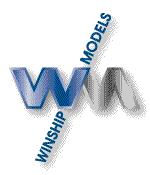Ok so you made a trip down to
the hobby shop and bought a few propellers. The next step is to bolt
the props to the engines right? I have been guilty of this in the past but
there are some things you should do before bolting the prop to the engine such
as balancing and removing sharp edges. Checking the pitch is a good idea
especially if you are flying the racing events.
Props come in many varieties and
there are pros and cons to each variety. I am not an expert on propellers
but will discuss what I have found over the years by making and experimenting
with different props.
The wood prop is still one of
the better material choices for a prop. Wood is the lightest material,
even lighter than carbon in some cases depending on the lay-up of the composite
prop (resin to fiber ratio) and the type of wood used. Wood props seem to
allow the engine to accelerate at a faster rate than some heavier props.
Attention to the grain type and uniformity of the grain is important when
selecting a wood prop. Most if not all wood prop manufacturers use only
the best wood (usually hard maple) but a good tight straight grain that is
uniform on both blades will help when it comes to balancing. The wood prop
in my opinion is the most vulnerable to distortion. After working with
wood for the better part of my life I have come to understand that wood has a
mind of it's own. It likes to bend and twist depending on the grain and
built in stresses. A wood prop can be machined accurate and distort when
material is removed from the blank in the machining process. I believe this is
why the larger blades are more likely to be laminated from several
layers of wood. I recently purchased two 20x6-10 props for a Zenoah G-45. I compared
these props on a pitch gauge and they were off by two inches of pitch at the
tips. One blade was 10 inches at the tip while the other was 12 inches of
pitch at the tip. This pitch difference is enough to cause the plane to
fly considerably faster with the 12 pitch prop than the 10 pitch. The
20x6-10 means that it is 6 inches of pitch at the hub and progresses to 10
inches at the tip. If you are off at the tip it will have a greater effect
than if the pitch is off at the hub. Another difference between these
props were the airfoil cross sections at the tip. One blade had a thicker air foiled
tip while the other was more flat. If the blade is thick
enough, material can be taken from the face of the blade (the part of the blade
that is facing rearward when mounted) at the trailing edge to remove some of the
pitch.
Plastic/Composite props:
These props are inherently accurate due to the stability of the materials used
in their construction and CNC molds they are made of. These props usually utilize
glass filled Nylon which further enhance their strength. These props in
the larger sizes (16" and above) become heavy and prone to stress at the
hubs under extreme loads such as racing.
Carbon Fiber and Fiber Glass
Props: True composite props are always hand layed and labor
intensive. The fibers in these props are usually the full length of the
blade. Some of the larger props are hollow and use carbon fiber woven
cloth to form the blade shells. The accuracy of these props are dependant
on the fabricators attention to detail but when done right offer tremendous
rigidity and light weight.
